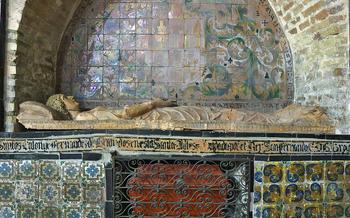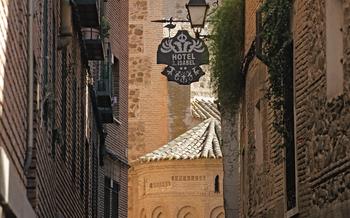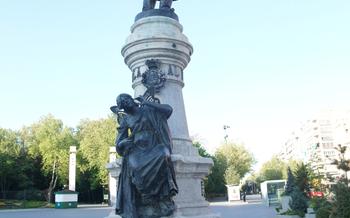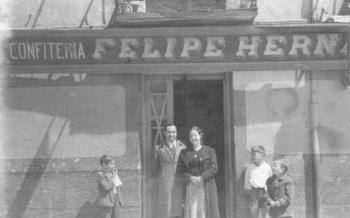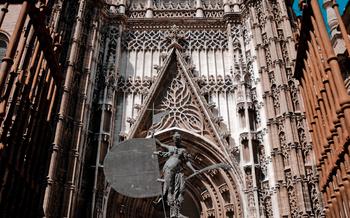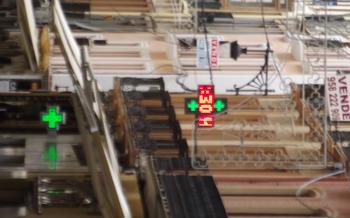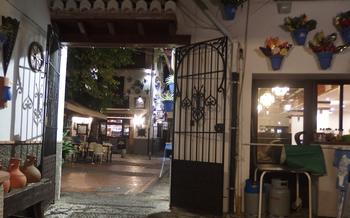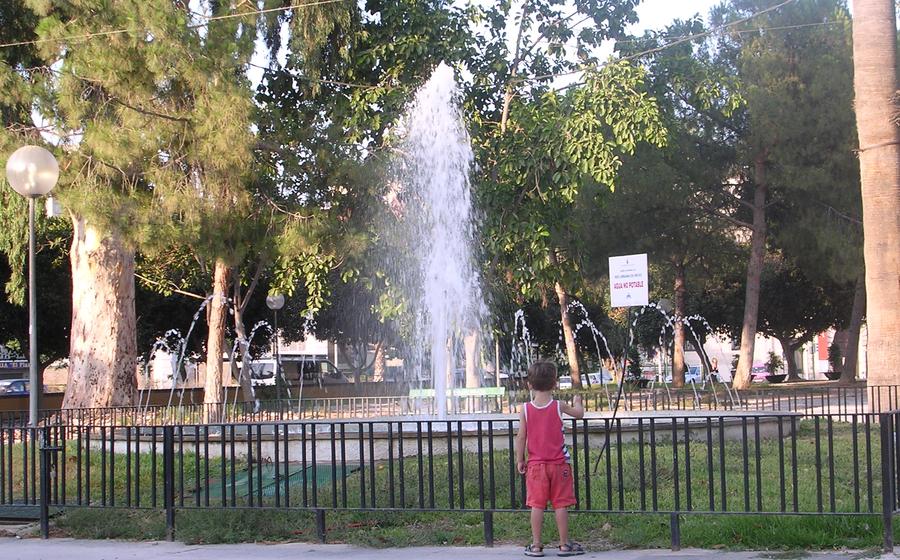
La Merced University Campus
- A Campus with History
- Renaissance-Style Architecture
- The San Esteban Cloister
- The Chapel of La Merced
- The Faculty of Law Building
- The Faculty of Philosophy and Education Building
- The Faculty of Economics and Business Administration Building
- The La Merced Park
- The La Merced Library
- Student Life at La Merced
- Campus Tours and Events
- Getting to La Merced University Campus
- Where to Eat and Stay Near the Campus
- Tips for Visiting La Merced University Campus
- Insider Tip: Hidden Gems of the Campus
A Campus with History
La Merced University Campus is steeped in history, dating back to the 15th century when it was founded as a Franciscan monastery. Over the centuries, the campus has undergone various transformations, reflecting the changing educational and cultural landscape of Murcia. The campus's architectural styles range from Gothic to Renaissance to Baroque, showcasing the rich artistic heritage of the region. Notable historical figures associated with the campus include Alfonso X the Wise, who granted the university its royal charter in 1266, and Cardinal Belluga, who played a key role in the university's expansion and modernization in the 18th century. La Merced University Campus holds immense cultural significance as a hub of learning, research, and innovation, contributing to the intellectual and cultural development of Murcia and beyond.
Renaissance-Style Architecture
The La Merced University Campus is a showcase of Renaissance-style architecture, characterized by its balance, symmetry, and classical motifs. The Renaissance style, which originated in Italy in the 14th century, was embraced in Spain during the 16th and 17th centuries. It marked a departure from the Gothic style, emphasizing the human form, naturalism, and the revival of classical ideals.
On the La Merced campus, Renaissance elements can be seen in the harmonious proportions, arched doorways, and intricate stone carvings. The San Esteban Cloister, for example, features a series of elegant arches and columns, creating a serene and inviting space. The Chapel of La Merced, with its barrel-vaulted ceiling and ornate altar, is another stunning example of Renaissance architecture.
The Renaissance style not only influenced the aesthetics of the campus but also reflected the intellectual and cultural changes of the time. It symbolized a shift towards humanism, emphasizing the individual's potential and the pursuit of knowledge. The campus's Renaissance architecture stands as a testament to this era of intellectual and artistic flourishing in Spain.
The San Esteban Cloister
The San Esteban Cloister, with its serene atmosphere and exquisite architectural details, stands as a testament to the university's rich heritage. Constructed in the 16th century, the cloister exudes an aura of tranquility, with its graceful arches, intricate carvings, and a central fountain that adds to its charm. Its elegant Renaissance-style columns and vaulted ceilings create a harmonious blend of architectural elements.
Throughout the university's history, the San Esteban Cloister has served as a place of contemplation, learning, and social interaction for students and faculty. In its early days, the cloister functioned as a central gathering space for religious ceremonies, academic discussions, and communal gatherings. Its serene ambiance provided an ideal setting for scholars to engage in intellectual pursuits and seek spiritual enlightenment.
Today, the San Esteban Cloister continues to be a vibrant part of the university's campus, serving as a venue for various events, exhibitions, and performances. Its timeless beauty and historical significance make it a beloved landmark for students, staff, and visitors alike. Visitors to the cloister can admire its intricate details, soak in the peaceful atmosphere, and appreciate its enduring role in the university's history.
The Chapel of La Merced
The Chapel of La Merced, located within the La Merced University Campus, stands as an architectural and spiritual centerpiece of the university. Built in the 18th century, the chapel showcases a blend of Renaissance and Baroque styles, epitomizing the artistic and religious heritage of Murcia.
Architectural Features
The Chapel of La Merced captivates visitors with its intricate facade, adorned with delicate carvings and sculptures. The entrance is flanked by two elegant columns supporting a pediment, creating a sense of grandeur and solemnity. The interior of the chapel features a spacious nave, intricate vaulted ceilings, and an impressive altarpiece that serves as the focal point of the sanctuary.
History and Significance
The Chapel of La Merced holds immense historical significance, having served as a place of worship and contemplation for generations of students, faculty, and staff at the university. It was originally part of the La Merced Convent, founded in the 13th century, and later became an integral part of the university campus. The chapel has witnessed countless religious ceremonies, celebrations, and moments of reflection throughout its long and storied history.
The Chapel's Role in the University's History
The Chapel of La Merced has played a pivotal role in the university's history, serving as a spiritual and intellectual hub for the academic community. It has hosted numerous religious services, lectures, concerts, and cultural events, fostering a sense of unity and belonging among students and faculty. The chapel has also served as a venue for important ceremonies, such as graduations and award ceremonies, marking significant milestones in the lives of university members.
Current Use of the Chapel
Today, the Chapel of La Merced continues to serve as an active place of worship for the university community. It offers regular mass services, prayer groups, and spiritual retreats, providing a sanctuary for reflection and contemplation. The chapel also hosts various cultural and artistic events, such as concerts, exhibitions, and lectures, showcasing the university's commitment to fostering intellectual and spiritual growth.
The Faculty of Law Building
The Faculty of Law Building, with its striking Renaissance-inspired architecture, stands proudly on the La Merced University Campus. Constructed in the 16th century, this magnificent edifice has witnessed centuries of legal education and scholarship. Its imposing facade features intricate carvings, stone balconies, and a grand entrance that invites visitors to step into the world of law and justice.
Inside, the building boasts spacious lecture halls and classrooms, each adorned with elegant wooden paneling and high ceilings. The walls are lined with bookshelves, housing a vast collection of legal texts and volumes that have shaped the minds of generations of law students. The building's historic charm is further enhanced by its central courtyard, which serves as a tranquil gathering space for students and faculty alike.
Over the years, the Faculty of Law Building has played a pivotal role in the development of legal education in Spain. It has been home to renowned scholars, jurists, and legal professionals who have left an indelible mark on the nation's legal system. The building has also hosted countless conferences, seminars, and workshops, bringing together experts from around the world to engage in thought-provoking discussions on various legal issues.
Today, the Faculty of Law Building continues to serve as a vibrant center for legal education and research. It offers a comprehensive range of undergraduate and postgraduate programs, attracting students from across Spain and beyond. The building's rich history and exceptional facilities make it a sought-after destination for those seeking a world-class legal education in a truly inspiring environment.
The Faculty of Philosophy and Education Building
Constructed in the latter half of the 18th century, the Faculty of Philosophy and Education Building stands as a testament to the university's rich architectural heritage and evolving educational mission. Its imposing facade, adorned with intricate carvings and sculptures, reflects the influence of the Baroque style prevalent during its construction. The building's spacious interior features grand hallways, high ceilings, and elegant classrooms, providing a conducive environment for learning and intellectual pursuits.
Over the years, the Faculty of Philosophy and Education Building has played a pivotal role in shaping the university's academic landscape. It has been the home to renowned scholars and educators who have contributed to the advancement of knowledge in various fields, including philosophy, education, psychology, and sociology. The building has witnessed countless lectures, debates, and discussions that have ignited minds and fostered critical thinking among generations of students.
Currently, the Faculty of Philosophy and Education Building continues to serve as a vibrant hub for academic excellence. It houses state-of-the-art facilities, including modern classrooms, research laboratories, and a comprehensive library, catering to the needs of students and researchers alike. The building's rich history and architectural splendor, combined with its ongoing contributions to the university's academic pursuits, make it a significant landmark on the La Merced University Campus.
The Faculty of Economics and Business Administration Building
At the heart of the La Merced University Campus stands the Faculty of Economics and Business Administration building, a magnificent symbol of architectural prowess. This grand edifice, with its elegant lines and imposing facade, reflects the dynamic spirit of the university's business programs. Its spacious corridors and state-of-the-art facilities foster an environment conducive to learning and innovation. Here, students engage in rigorous academic pursuits, preparing themselves for successful careers in the ever-evolving world of business.
The Faculty of Economics and Business Administration is renowned for its highly esteemed programs in economics, finance, accounting, and marketing. Its faculty members are experts in their respective fields, actively engaged in research and scholarly work. The curriculum is designed to provide students with a comprehensive understanding of economic principles, financial markets, accounting practices, and marketing strategies. Additionally, the faculty fosters a strong emphasis on practical application through internships, case studies, and simulations, ensuring that graduates are well-equipped to navigate the complexities of the business world.
The building itself is a testament to the faculty's commitment to academic excellence. Its modern design incorporates sustainable features, creating a welcoming and eco-friendly learning environment. Ample natural light floods the classrooms and study areas, providing a bright and inviting atmosphere. The building's spacious layout facilitates collaboration and networking, enabling students to engage in meaningful discussions and build valuable connections.
The Faculty of Economics and Business Administration building is more than just an academic hub; it is a vibrant community where students, faculty, and staff come together to exchange ideas, share experiences, and learn from one another. It is a place where aspirations are nurtured, dreams are ignited, and the leaders of tomorrow are shaped.
The La Merced Park
The La Merced Park is a beautiful and historic green space located in the heart of the La Merced University Campus. It was created in the 16th century as a garden for the Mercedarian friars who lived in the monastery on the campus. The park was later opened to the public and has since become a popular spot for students, faculty, and visitors to relax and enjoy the outdoors.
The park is home to a variety of trees, flowers, and other plants, as well as a number of sculptures and fountains. It is also a popular spot for birdwatching, as many different species of birds can be seen in the park throughout the year.
The La Merced Park is a significant part of the university's history and culture. It has been used for a variety of events over the years, including concerts, plays, and festivals. It is also a popular spot for students to study, socialize, and relax.
Today, the park is a popular destination for both locals and tourists alike. It is a great place to take a stroll, relax on a bench, or enjoy a picnic. The park is also home to a number of events throughout the year, such as concerts, art exhibitions, and food festivals.
The La Merced Library
The La Merced Library is one of the most important libraries in the Region of Murcia, and it is also one of the oldest in Spain. It was founded in 1575 by the Jesuits, who were the first to establish a university in Murcia. The library's collection includes over 300,000 volumes, including many rare and valuable books.
The library is housed in a beautiful building that was built in the 18th century. The building has a baroque façade and a central courtyard. The library's interior is spacious and well-lit, with high ceilings and large windows. The library's collection is divided into several sections, including a general collection, a rare books collection, and a collection of manuscripts. The library also has a special collection of books on the history of Murcia and the Region of Murcia.
The La Merced Library is a valuable resource for students, researchers, and anyone who is interested in the history and culture of Murcia. The library's staff is friendly and helpful, and they are always willing to assist visitors with their research. The library also offers a variety of programs and events, including lectures, workshops, and exhibitions.
The La Merced Library is a must-see for anyone who is visiting the La Merced University Campus. The library is a treasure trove of information and a beautiful example of Spanish Baroque architecture.
Student Life at La Merced
La Merced University Campus fosters a vibrant and diverse student community. The campus buzzes with activities, events, and traditions that enrich the student experience beyond academics.
Students at La Merced are encouraged to actively participate in various student organizations and clubs that cater to a wide range of interests, from sports and music to cultural and social causes. These organizations offer opportunities for students to connect with like-minded individuals, develop leadership skills, and contribute to the campus community.
The university also hosts numerous student events and festivals throughout the year, providing students with opportunities to socialize, celebrate, and showcase their talents. These events include cultural festivals, music concerts, sports competitions, and traditional Spanish celebrations.
La Merced's international student community adds to the cultural diversity of the campus. Students from various countries bring their unique perspectives and experiences, fostering a global atmosphere that encourages cross-cultural exchange and understanding.
Overall, La Merced University Campus offers a dynamic and fulfilling student life, providing students with ample opportunities for personal growth, social engagement, and cultural exploration.
Campus Tours and Events
La Merced University Campus offers a variety of guided tours that provide an in-depth look at the campus's history, architecture, and culture. Tours are available in Spanish and English and can be booked in advance online or by calling the university's visitor center.
In addition to regular tours, the campus also hosts a number of special events and exhibitions throughout the year. These events include art shows, concerts, lectures, and workshops. For a full list of upcoming events, visit the university's website or social media pages.
Whether you're a prospective student, a history buff, or simply someone who enjoys exploring beautiful campuses, La Merced University Campus is a must-see destination. With its rich history, stunning architecture, and vibrant student life, the campus is sure to leave a lasting impression.
To book a tour or attend an event:
- Visit the university's website or call the visitor center.
- Choose from a variety of tour options, including general tours, historical tours, and architecture tours.
- Book your tour in advance to secure your spot.
- Check the university's website or social media pages for information on upcoming events.
Tips for making the most of your visit:
- Allow plenty of time to explore the campus, as there is much to see and do.
- Wear comfortable shoes, as you will be doing a lot of walking.
- Bring a camera to capture the campus's beauty.
- Take advantage of the opportunity to talk to students and staff to learn more about the university.
Getting to La Merced University Campus
La Merced University Campus is conveniently located in the heart of Murcia, Spain. It is easily accessible by public transportation, making it a breeze for visitors to reach the campus. Several bus lines stop nearby, providing direct connections to different parts of the city. The campus is also within walking distance of the Murcia train station, offering easy access for those arriving by rail.
For those who prefer to drive, the campus is situated near major roads and highways, ensuring a smooth and convenient journey. Ample parking is available on campus, allowing visitors to park their vehicles safely and conveniently. Additionally, the campus is wheelchair accessible, with ramps and elevators provided for easy navigation.
Where to Eat and Stay Near the Campus
To fully immerse yourself in the campus experience, consider dining and staying near La Merced University Campus. The surrounding area offers a diverse range of culinary options and accommodations to suit every taste and budget.
For a truly Murcian experience, head to Restaurante La Casona, renowned for its traditional dishes prepared with fresh, local ingredients. La Taberna del Tío Perico is another local favorite, offering a delightful menu of tapas and regional specialties in a cozy and authentic setting.
If you prefer international cuisine, La Pizzería del Campus serves up delicious pizzas and Italian fare, while El Mesón del Dragón offers a taste of Asian cuisine with its flavorful dishes.
For your accommodation needs, Hotel La Merced is a convenient option located just steps away from the campus. It offers comfortable rooms, modern amenities, and a friendly atmosphere. For a more budget-friendly choice, Hostal El Rincón provides clean and basic accommodations at an affordable price.
For those seeking a unique stay, consider booking a room at the Parador de Murcia. This historic hotel is housed in a former convent and offers stunning views of the city.
When it comes to finding budget-friendly options, look for hostels, guesthouses, or Airbnb rentals in the vicinity of the campus. These options often offer shared spaces and cooking facilities, allowing you to save on expenses while still enjoying a comfortable and social experience.
Be sure to sample local specialties such as paella, gazpacho, and chuletas de cordero (grilled lamb chops) during your visit. La Merced University Campus is a vibrant and welcoming place, and exploring its culinary and accommodation offerings will only enhance your overall experience.
Tips for Visiting La Merced University Campus
To make the most of your visit to La Merced University Campus, consider these helpful tips:
-
Best time to visit: Aim for spring or fall, when the weather is pleasant, and the campus is less crowded. Summers can be hot and humid, while winters are mild but rainy.
-
What to wear and pack: Dress respectfully, as the campus is a place of learning and research. Comfortable walking shoes are a must, as you'll likely be doing a lot of exploring. Don't forget your camera to capture the campus's beauty.
-
Safety tips: The campus is generally safe, but it's always wise to be vigilant. Stick to well-lit areas at night, and be aware of your surroundings.
-
Etiquette and cultural norms: Be respectful of students and staff, and remember that the campus is a place of education. Avoid loud noises and disruptions, and refrain from smoking or littering.
-
Insider tips: To experience the campus like a local, grab a coffee at one of the student cafes or join a guided tour to learn more about its history and architecture. Don't miss the opportunity to visit the La Merced Library, home to a vast collection of books and manuscripts.
Insider Tip: Hidden Gems of the Campus
-
The Secret Garden: Nestled amidst the university's historic buildings, the Secret Garden is a tranquil oasis, offering breathtaking views of the city and the surrounding mountains.
-
The Rooftop Terrace: Climb to the top of the Faculty of Law building for a panoramic view of the campus and the city beyond. It's the perfect spot to catch a sunset or enjoy a picnic.
-
The Hidden Museum: Tucked away in the basement of the Faculty of Philosophy and Education building, the Hidden Museum houses a collection of ancient artifacts and historical documents that tell the story of the university's rich past.
-
The Student Art Gallery: Showcasing the talents of La Merced's students, the Student Art Gallery hosts regular exhibitions featuring a variety of artistic styles and mediums.
-
The Underground Tunnel: Rumored to connect the university's buildings, the Underground Tunnel is a mysterious and intriguing passageway that adds to the campus's allure.
